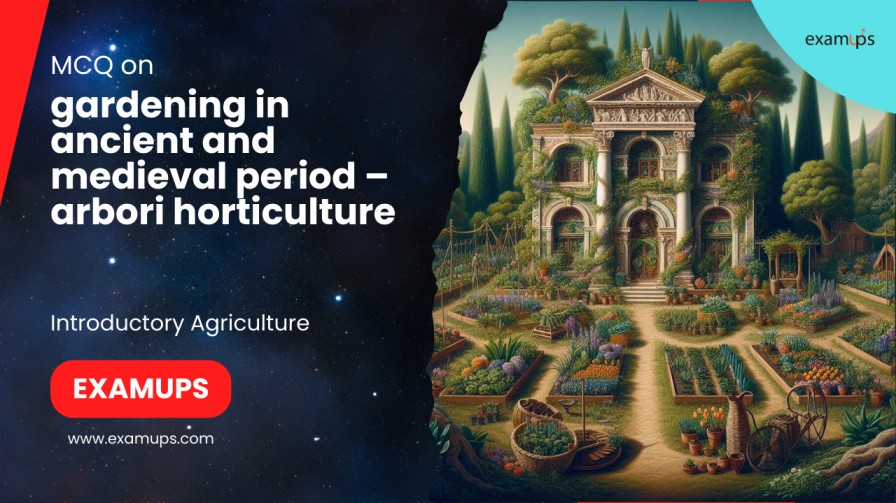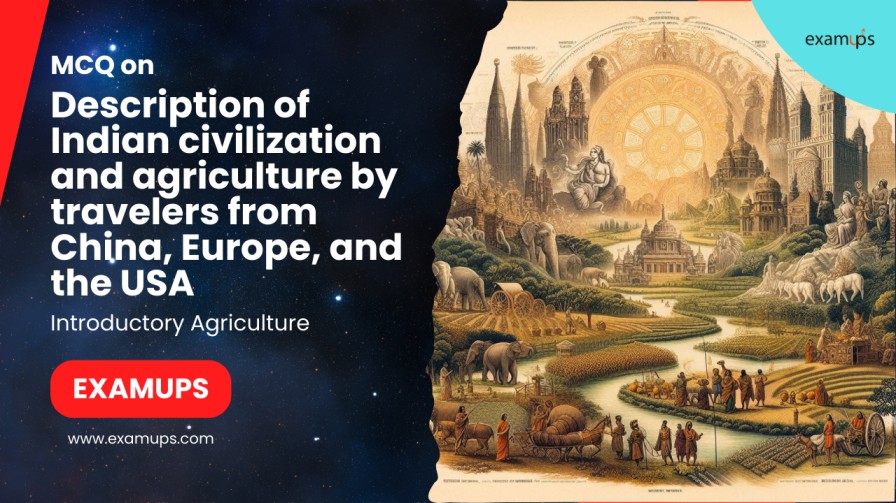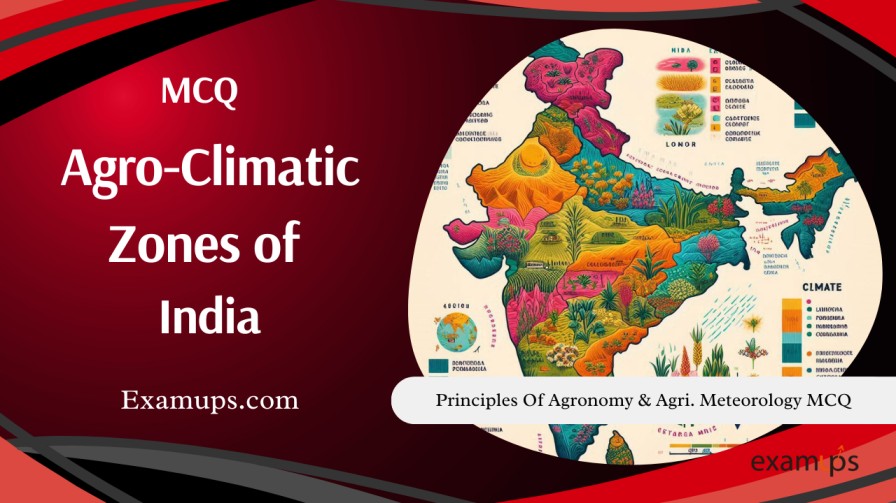Gardening in ancient and medieval period – arbori horticulture MCQ for ICAR-JEF, ICAR-SRF, ICAR-NET, IBPS-AFO/SO, Pre-PG, BHU Pre-PG, IFFCO-AGT, CCI, FCI, B.sc, M.sc, All Agriculture Competitive Exams.
1. Which civilization revered trees and worshipped them during the Chalcolithic period?
– A) Mesopotamian Civilization
– B) Egyptian Civilization
– C) Indus Valley Civilization
– D) Greek Civilization
**Answer: C) Indus Valley Civilization**
Explanation: The passage mentions that during the chalcolithic period, the people of the Indus
Valley Civilization had great reverence for trees and worshipped them.
2. Which tree was considered sacred by the ancient people of the Indus Valley?
– A) Mango
– B) Neem
– C) Oak
– D) Pine
**Answer: B) Neem**
Explanation: The passage specifically mentions neem (Azadirachta indica) as one of the sacred trees
held in reverence by the ancient people of the Indus Valley.
3. What is the term used to describe the belief that trees were symbolic of gods and goddesses in the
Indus Valley Civilization?
– A) Arboreal Worship
– B) Vriksha Devata
– C) Botanic Devotion
– D) Tree Deification
**Answer: B) Vriksha Devata**
Explanation: The passage mentions the belief in vriksha devata or vriksha devi, which refers to the
gods and goddesses believed to dwell within trees in the Indus Valley Civilization.
4. According to the passage, what were trees considered to be in ancient India?
– A) Merely Natural Elements
– B) Divine and Spiritual Entities
– C) Economic Resources Only
– D) Obstacles to Human Progress
**Answer: B) Divine and Spiritual Entities**
Explanation: The passage states that in ancient India, trees were considered divine and spiritual,
symbolizing various aspects such as tree knowledge, the tree of life, and medicinal properties.
5. What literary texts mentioned the Cosmic Tree rooted in the Brahman during the Mauryan period?
– A) Vedas and Upanishads
– B) Greek Epics
– C) Chinese Classics
– D) Persian Poetry
**Answer: A) Vedas and Upanishads**
Explanation: The passage states that texts like Vedas and Upanishads from the Mauryan period
described the Cosmic Tree rooted in the Brahman.
6. Which period saw vast secular literature and texts discussing various aspects of trees and nature?
– A) Gupta Period
– B) Mauryan Period
– C) Vedic Period
– D) Kushan Period
**Answer: B) Mauryan Period**
Explanation: The passage mentions that after the rise of the Mauryas in the 4th to 3rd century BC,
there was vast secular literature and texts discussing trees and nature.
7. What were the branches of the Cosmic Tree described in the Upanishads?
– A) Wood, Leaves, and Fruits
– B) Space, Wind, Fire, Water, and Earth
– C) Love, Hope, and Faith
– D) Sun, Moon, and Stars
**Answer: B) Space, Wind, Fire, Water, and Earth**
Explanation: According to the passage, the Upanishads describe the branches of the Cosmic Tree as
space, wind, fire, water, and earth.
8. Which tree was personified as human attributes in the archaeological evidences of Mohenjo-daro
and Harappa?
– A) Mango
– B) Pipal (Ficus religiosa)
– C) Olive
– D) Willow
**Answer: B) Pipal (Ficus religiosa)**
Explanation: The passage mentions that in archaeological evidences of Mohenjo-daro and Harappa,
certain trees like pipal were personified with human attributes.
9. What did trees symbolize in the Indus Valley Civilization?
– A) Material Wealth
– B) Environmental Balance
– C) Gods and Goddesses
– D) Agricultural Productivity
**Answer: C) Gods and Goddesses**
Explanation: The passage indicates that in the Indus Valley Civilization, trees were believed to
symbolize gods and goddesses, with divine entities dwelling within them.
10. Which period marked the belief in trees as the tree of life and medicinal resources?
– A) Gupta Period
– B) Vedic Period
– C) Mauryan Period
– D) Harappan Period
**Answer: B) Vedic Period**
Explanation: The passage suggests that in ancient India, particularly during the Vedic period, trees
were believed to symbolize the tree of life and were also seen as medicinal resources.
11. Which tree is identified with Shiva in Brahmanical religion?
– A) Ashoka (Saraca asoca)
– B) Asvattha (Ficus religiosa)
– C) Banyan (Ficus benghalensis)
– D) Bilva (Aegle marmelos)
**Answer: B) Asvattha (Ficus religiosa)**
Explanation: According to the passage, in Brahmanical religion, the tree identified with Shiva is
asvattha (Ficus religiosa).
12. Which of the following trees is associated with Lord Buddha’s birth and attainment of nirvana?
– A) Ashoka (Saraca asoca)
– B) Pipal (Ficus religiosa)
– C) Banyan (Ficus benghalensis)
– D) Amla (Emblica officinalis)
**Answer: B) Pipal (Ficus religiosa)**
Explanation: The passage mentions that Lord Buddha was born under the pipal tree and attained
nirvana under the bodhi tree, which is also a type of pipal tree.
13. What kind of tree is the bodhi tree, sacred to Buddhists?
– A) Banyan (Ficus benghalensis)
– B) Ashoka (Saraca asoca)
– C) Pipal (Ficus religiosa)
– D) Amla (Emblica officinalis)
**Answer: C) Pipal (Ficus religiosa)**
Explanation: The passage indicates that the bodhi tree, under which the Buddha attained nirvana,
is sacred to Buddhists, and it is a type of pipal tree.
14. Which of the following literary works describes the layout of gardens and parks in the city of
Indraprastha?
– A) Vedas
– B) Ramayana
– C) Mahabharata
– D) Jatakas
**Answer: C) Mahabharata**
Explanation: The passage mentions that the layout of gardens and parks in the city of Indraprastha
is described in the Sabha-Parva of the Mahabharata.
15. Which tree is predominant in the Ashokavana or Panchavati garden where Sita was held captive
in the Ramayana?
– A) Bilva (Aegle marmelos)
– B) Amla (Emblica officinalis)
– C) Ashoka (Saraca asoca)
– D) Asvattha (Ficus religiosa)
**Answer: C) Ashoka (Saraca asoca)**
Explanation: The passage mentions that Ashoka trees were predominant in the Ashokavana or
Panchavati garden where Sita was held captive in the Ramayana.
16. According to the passage, which literary work mentions Kalpavrksa and kalpalata?
– A) Vedas
– B) Ramayana
– C) Mahabharata
– D) Jatakas
**Answer: B) Ramayana**
Explanation: The passage states that Kalpavrksa and kalpalata are mentioned in the Ramayana.
17. Who described the art of gardening?
– A) Vatsyayana
– B) Sarangdhara
– C) Shudraka
– D) Kalidasa
**Answer: B) Sarangdhara**
Explanation: The passage mentions Sarangdhara as the one who described the art of gardening.
18. Which tree is associated with Surya (Sun) in Brahmanical religion?
– A) Ashoka (Saraca asoca)
– B) Asvattha (Ficus religiosa)
– C) Lotus
– D) Nine leaves of nine trees (navapatrika)
**Answer: C) Lotus**
Explanation: According to the passage, the lotus is associated with Surya (Sun) in Brahmanical
religion.
19. What kind of tree is Kalpavrksa?
– A) Wish-fulfilling tree
– B) Mango tree
– C) Neem tree
– D) Oak tree
**Answer: A) Wish-fulfilling tree**
Explanation: Kalpavrksa is described as a wish-fulfilling tree in the passage.
20. In which literary work is Ashokavana or Panchavati mentioned?
– A) Vedas
– B) Ramayana
– C) Mahabharata
– D) Jatakas
**Answer: B) Ramayana**
Explanation: The passage mentions Ashokavana or Panchavati in the Ramayana.
21. Who is credited with the planting of roadside avenue trees (margeshuvriksha) according to the
passage?
– A) King Harsha
– B) King Chandragupta Maurya
– C) King Ashoka
– D) King Akbar
**Answer: C) King Ashoka**
Explanation: The passage states that the planting of roadside avenue trees was an important
contribution of King Ashoka.
22. Which tree is NOT mentioned as being part of the trees and plants in Vedic times?
– A) Mango
– B) Neem
– C) Olive
– D) Tulsi (Ocimum sanctum)
**Answer: C) Olive**
Explanation: The passage lists various trees and plants from Vedic times, including mango, neem,
tulsi, but does not mention olive.
23. What tree motif has been found in the art of the Indus Valley according to the passage?
– A) Mango tree
– B) Neem tree
– C) Banyan tree
– D) Pipal tree
**Answer: D) Pipal tree**
Explanation: The passage mentions tree motifs found in the art of the Indus Valley, including the
pipal tree.
24. Which architectural feature bears testimony to the importance of plants and flowers in ancient
India?
– A) Pillars of Ashoka
– B) Mauryan ring stones
– C) Ajanta frescoes
– D) Stupas at Bharhut
**Answer: C) Ajanta frescoes**
Explanation: The passage mentions that old sculptures and architecture of Ajanta frescoes bear
testimony to the importance of plants and flowers in ancient India.
25. Which tree is associated with Shiva according to the passage?
– A) Mango
– B) Pipal (Ficus religiosa)
– C) Neem
– D) Tulsi (Ocimum sanctum)
**Answer: B) Pipal (Ficus religiosa)**
Explanation: The passage states that in Brahmanical religion, the asvattha (Ficus religiosa) was
identified with Shiva.
26. What is the botanical name for tulsi according to the passage?
– A) Nelumbo nucifera
– B) Azadirachta indica
– C) Ocimum sanctum
– D) Terminalia arjuna
**Answer: C) Ocimum sanctum**
Explanation: The passage mentions tulsi with the botanical name Ocimum sanctum.
27. Which tree is mentioned as being predominant in Ashokavana or Panchavati in the Ramayana?
– A) Mango
– B) Neem
– C) Ashoka (Saraca asoca)
– D) Banyan (Ficus benghalensis)
**Answer: C) Ashoka (Saraca asoca)**
Explanation: The passage states that Ashoka trees were predominant in Ashokavana or Panchavati
in the Ramayana.
28. Which tree is associated with Surya (Sun) in Brahmanical religion?
– A) Mango – B) Banyan (Ficus benghalensis) – C) Lotus (Nelumbo nucifera) – D) Pipal (Ficus religiosa)
**Answer: C) Lotus (Nelumbo nucifera)**
Explanation: The passage mentions that lotus is associated with Surya (Sun) in Brahmanical religion.
29. Which tree is sacred to Buddhists as the tree under which Buddha attained nirvana?
– A) Pipal (Ficus religiosa) – B) Banyan (Ficus benghalensis) – C) Ashoka (Saraca asoca) – D) Tulsi (Ocimum sanctum)
**Answer: A) Pipal (Ficus religiosa)**
Explanation: The passage mentions that the tree under which Buddha attained nirvana is sacred to
Buddhists, and it is a type of pipal tree.
30. Which architectural feature contains relief sculptures particularly depicting the importance of
plants and flowers?
– A) Ashokan Pillar Capitals – B) Stupas at Bharhut – C) Mauryan ring stones – D) Ajanta frescoes
**Answer: A) Ashokan Pillar Capitals**
Explanation: The passage mentions that Mauryan relief sculptures, particularly on the Ashokan
Pillar Capitals, depict the importance of plants and flowers.
31. Jain Tirthankaras in Indian art date back from the ______ century AD to 1200 AD.
– A) 1st – B) 6th – C) 11th – D) 15th
**Answer: D) 15th**
Explanation: The passage states that Jain Tirthankaras in Indian art date back from the 15th century
AD to 1200 AD.
32. Which ancient coins depict trees and flowers at various sites mentioned in the passage?
– A) Coins of Mauryan Empire – B) Coins of Gupta Empire – C) Coins of Mitra Kings – D) Coins of Pandyan Territory
**Answer: C) Coins of Mitra Kings**
Explanation: The passage mentions that ancient coins found at various sites, including those of the
Mitra Kings, depict trees and flowers.
33. What is the science of plant life mentioned in the passage?
– A) Vrikshayurveda – B) Botanology – C) Dendrology – D) Arboriculture
**Answer: A) Vrikshayurveda**
Explanation: The passage mentions the science of plant life as Vrikshayurveda.
34. Which period saw the renaissance of gardening in India by the Mughal rulers?
– A) Gupta period – B) Harappan period – C) Mughal period – D) Mauryan period
**Answer: C) Mughal period**
Explanation: The passage states that the renaissance of gardening in India by the Mughal rulers
began during the Mughal period.
35. In which book did Babur describe gardening in India?
– A) Akbarnama – B) Tuzuk-i-Jahangiri – C) Baburnama – D) Bagh-I-Wafa
**Answer: D) Bagh-I-Wafa**
Explanation: The passage mentions that Babur described gardening in India in the book Bagh-I
Wafa.
36. Which Mughal garden is associated with the Taj Mahal?
– A) Shalimar Garden – B) Nishat Garden – C) Pinjore Garden – D) Taj Mahal Garden
**Answer: D) Taj Mahal Garden**
Explanation: The passage mentions the Taj Mahal Garden as one of the most important Mughal
gardens.
37. During which centuries were Mughal gardens developed in various places mentioned in the
passage?
– A) 12th and 13th centuries AD – B) 14th and 15th centuries AD – C) 16th and 17th centuries AD – D) 18th and 19th centuries AD
**Answer: C) 16th and 17th centuries AD**
Explanation: The passage states that during the 16th and 17th centuries AD, Mughal gardens were
developed in various places.
38. What was a remarkable contribution of ancient Indians according to the passage?
– A) Introduction of new plant species – B) Conservation of trees and biodiversity – C) Development of modern gardening techniques – D) Promotion of deforestation
**Answer: B) Conservation of trees and biodiversity**
Explanation: The passage highlights the ancient Indians’ concern with the conservation of trees and
biodiversity as a remarkable contribution.
39. Which dynasty brought many plant species from Persia and Central Asia to India?
– A) Gupta Dynasty – B) Mauryan Dynasty – C) Mughal Dynasty – D) Chola Dynasty
**Answer: C) Mughal Dynasty**
Explanation: The passage mentions that the Mughal rulers brought many plant species from Persia
and Central Asia to India.
40. Which type of paintings illustrate many flowers and were bordered with illustrations of flowers?
– A) Rajput paintings – B) Pahari paintings – C) Mughal paintings – D) Deccani paintings
**Answer: C) Mughal paintings**
Explanation: The passage mentions that Mughal paintings illustrate many flowers and were
bordered with illustrations of flowers.
41. Who introduced the rose into India via the port of Bussorah around 1526?
– A) Akbar – B) Jahangir – C) Babur – D) Shah Jahan
**Answer: C) Babur**
Explanation: The passage states that the rose was introduced into India via the port of Bussorah by
Babur around 1526.
42. Which Mughal ruler introduced important plants in Kashmir including the majestic Chinar tree
and the weeping willow?
– A) Akbar – B) Shah Jahan – C) Aurangzeb – D) Jahangir
**Answer: D) Jahangir**
Explanation: The passage mentions that Mughal ruler Jahangir introduced important plants in
Kashmir, including the Chinar tree and the weeping willow.
43. Who laid out the famous Shalimar Bagh in Srinagar?
– A) Shah Jahan – B) Babur – C) Aurangzeb – D) Jahangir
**Answer: D) Jahangir**
Explanation: The passage states that Mughal ruler Jahangir laid out the famous Shalimar Bagh in
Srinagar.
44. Which missionary introduced exotic plants and wrote a book on gardening in India?
– A) Dr. Firminger – B) Dr. Livingstone – C) Dr. Foster – D) Dr. Anderson
**Answer: A) Dr. Firminger**
Explanation: The passage mentions Dr. Firminger as a missionary who introduced exotic plants and
wrote a book on gardening in India.
45. Which book written by Dr. Firminger serves as an authoritative reference book on ornamental flowering plants?
– A) Indian Gardening Guide – B) Firminger’s Manual of Gardening in India – C) Exotic Plants Encyclopedia – D) Botanical Garden Handbook
**Answer: B) Firminger’s Manual of Gardening in India**
Explanation: The passage states that the book titled ‘Firminger’s Manual of Gardening in India’
serves as an authoritative reference book on ornamental flowering plants.
46. Which British rulers established Government Botanic Gardens in India during the 18th and 19th
centuries?
– A) French rulers – B) Dutch rulers – C) Portuguese rulers – D) British rulers
**Answer: D) British rulers**
Explanation: The passage mentions that Government Botanic Gardens were established by the
British rulers during the 18th and 19th centuries in India.
47. Which botanical garden introduced the Giant Amazon lily, Victoria regia, into India?
– A) Lalbagh Botanical Garden, Bangalore – B) Government Botanic Garden, Saharanpur – C) Indian Botanic Garden, Sibpur, Calcutta – D) Lloyd Botanic Garden, Darjeeling
**Answer: C) Indian Botanic Garden, Sibpur, Calcutta**
Explanation: The passage states that the Indian Botanic Garden in Sibpur, Calcutta, introduced the
Giant Amazon lily, Victoria regia, into India.
48. Which botanical garden introduced the mahogany (Swietenia mahogany) from Jamaica in 1795?
– A) Lalbagh Botanical Garden, Bangalore – B) Government Botanic Garden, Saharanpur – C) Indian Botanic Garden, Sibpur, Calcutta – D) Lloyd Botanic Garden, Darjeeling
**Answer: A) Lalbagh Botanical Garden, Bangalore**
Explanation: The passage mentions that Lalbagh Botanical Garden in Bangalore introduced the
mahogany from Jamaica in 1795.
49. Which Mughal garden is associated with the tomb of Humayun in Delhi?
– A) Shalimar Bagh – B) Nishat Bagh – C) Pinjore Garden – D) Humayun’s Tomb Garden
**Answer: D) Humayun’s Tomb Garden**
Explanation: The passage states that the garden at Humayun’s Tomb in Delhi is associated with
Mughal ruler Humayun.
50. What flower was introduced into India by Babur via the port of Bussorah?
– A) Tulip – B) Daffodil – C) Rose – D) Iris
**Answer: C) Rose**
Explanation: The passage states that Babur introduced the rose into India via the port of Bussorah.
51. Which tree species is native to India according to the passage?
– A) Maple (Acer) – B) Pine (Pinus) – C) Eucalyptus (Eucalyptus) – D) Neem (Azadirachta indica)
**Answer: D) Neem (Azadirachta indica)**
Explanation: The passage lists Neem (Azadirachta indica) as one of the native Indian ornamental
plants.
52. Which shrub is mentioned in the passage?
– A) Rhododendron – B) Magnolia – C) Lilac – D) Boxwood
**Answer: A) Rhododendron**
Explanation: The passage mentions Rhododendron as a shrub.
53. Which plant is listed under the category of climbers?
– A) Tulip – B) Hibiscus – C) Clematis paniculata – D) Jasmine
**Answer: C) Clematis paniculata**
Explanation: Clematis paniculata is listed as a climber in the passage.
54. What is a seasonal flower mentioned in the passage?
– A) Rose – B) Tulip – C) Celosia – D) Orchid
**Answer: C) Celosia**
Explanation: Celosia is mentioned as a seasonal flower in the passage.
55. Which plant is listed under the category of bulbous flowers?
– A) Orchid – B) Gloriosa superba – C) Poinsettia – D) Begonia
**Answer: B) Gloriosa superba**
Explanation: Gloriosa superba is listed as a bulbous flower in the passage.
56. What is the scientific name of the Neem tree?
– A) Azadirachta indica – B) Albizzia lebbeck – C) Cassia fistula – D) Saraca asoca
**Answer: A) Azadirachta indica**
Explanation: Azadirachta indica is the scientific name of the Neem tree mentioned in the passage.
57. Which plant is NOT listed under the climbers category?
– A) Hiptage benghalensis – B) Porana paniculata – C) Allium giganteum – D) Thunbergia grandiflorum
**Answer: C) Allium giganteum**
Explanation: Allium giganteum is listed under bulbous flowers, not climbers.
58. Which plant is specifically mentioned as a native Indian ornamental tree?
– A) Maple (Acer) – B) Pine (Pinus) – C) Neem (Azadirachta indica) – D) Cedar (Cedrus)
**Answer: C) Neem (Azadirachta indica)**
Explanation: Neem (Azadirachta indica) is specifically mentioned as a native Indian ornamental
tree.
59. Which flowering plant is NOT listed under the seasonal flowers category?
– A) Amaranthus spp. – B) Celosia – C) Lady’s lace (Pimpinella monoica) – D) Orchids (Aerides)
**Answer: D) Orchids (Aerides)**
Explanation: Orchids (Aerides) are not listed under the seasonal flowers category.
60. Which plant is mentioned as both a tree and a climber in the passage?
– A) Clematis paniculata – B) Rhododendron – C) Azadirachta indica (Neem) – D) Allium giganteum
**Answer: C) Azadirachta indica (Neem)**
Explanation: Neem (Azadirachta indica) is listed as both a tree and a climber in the passage.










